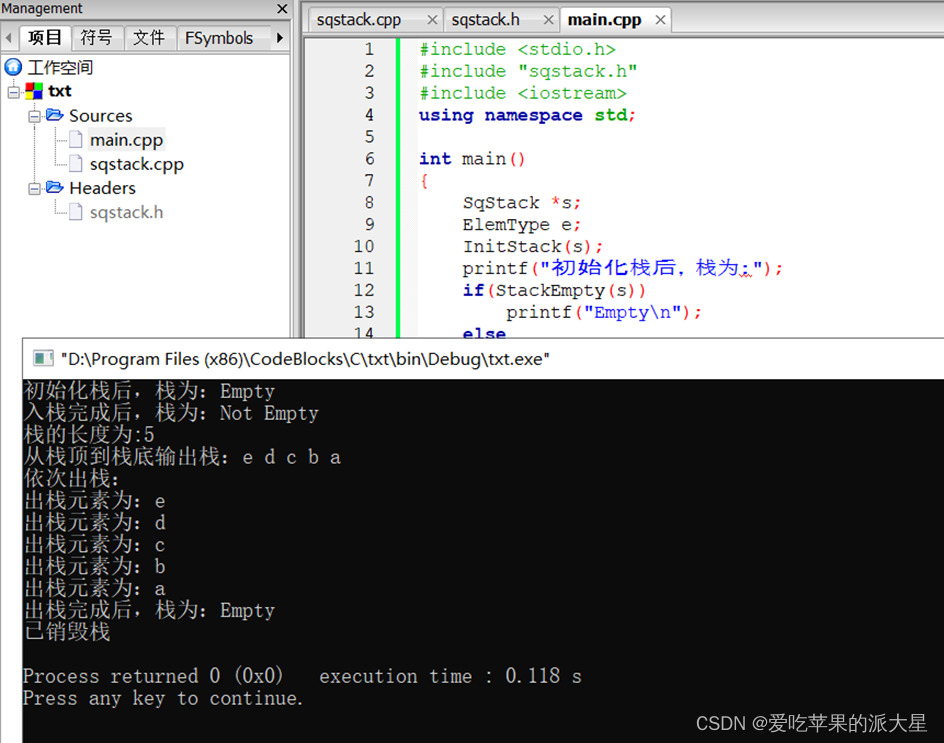一、实验目的
- 理解和掌握栈的类型定义方法。
- 掌握栈中的基本运算,包括创建、判空及判满、出栈/入栈等基本操作。
- 学习利用栈解决实际问题
二、实验要求
【项目1 – 验证性实验:建立顺序栈、链栈】
【要求】:
1、头文件sqstack.h中定义数据结构并声明用于完成基本运算的函数。对应基本运算的函数包括:
2、在sqstack.cpp中实现这些函数
3、在main函数中完成测试,包括如下内容:
(1)初始化栈s
(2)判断s栈是否为空
(3)依次进栈元素a,b,c,d,e
(4)判断s栈是否为空
(5)输出栈长度
(6)输出从栈顶到栈底元素
(7)出栈,并输出出栈序列
(8)判断s栈是否为空
(9)释放栈
main.cpp程序代码:
#include <stdio.h>
#include "sqstack.h"
#include <iostream>
using namespace std;
int main()
{
SqStack *s;
ElemType e;
InitStack(s);
printf("初始化栈后,栈为:");
if(StackEmpty(s))
printf("Empty\n");
else
printf("Not Empty\n");
Push(s,'a');
Push(s,'b');
Push(s,'c');
Push(s,'d');
Push(s,'e');
printf("入栈完成后,栈为:");
if(StackEmpty(s))
printf("Empty\n");
else
printf("Not Empty\n");
printf("栈的长度为:%d\n",StackLength(s));
printf("从栈顶到栈底输出栈:");
DispStack(s);
printf("依次出栈:\n");
Pop(s,e);
printf("出栈元素为:%c\n",e);
Pop(s,e);
printf("出栈元素为:%c\n",e);
Pop(s,e);
printf("出栈元素为:%c\n",e);
Pop(s,e);
printf("出栈元素为:%c\n",e);
Pop(s,e);
printf("出栈元素为:%c\n",e);
printf("出栈完成后,栈为:");
if(StackEmpty(s))
printf("Empty\n");
else
printf("Not Empty\n");
DestroyStack(s);
printf("已销毁栈\n");
return 0;
}
运行结果图:

1.头文件:listack.h,包含定义链栈数据结构的代码、宏定义、要实现算法的函数的声明;
2.源文件:listack.cpp,包含实现各种算法的函数的定义
3.在同一项目(project)中建立一个源文件(如main.cpp),编制main函数,完成相关的测试工作。 包括如下内容:
(1)初始化栈s
(2)判断s栈是否为空
(3)依次进栈元素a,b,c,d,e
(4)判断s栈是否为空
(5)输出栈长度
(6)输出从栈顶到栈底元素
(7)出栈,并输出出栈序列
(8)判断s栈是否为空
(9)释放栈
main.cpp程序代码:
#include <stdio.h>
#include "listack.h"
#include <iostream>
using namespace std;
int main()
{
LiStack *s;
ElemType e;
InitStack(s);
printf("初始化栈后,栈为:");
if(StackEmpty(s))
printf("Empty\n");
else
printf("Not Empty\n");
Push(s,'a');
Push(s,'b');
Push(s,'c');
Push(s,'d');
Push(s,'e');
printf("入栈a,b,c,d,e完成后,栈为:");
if(StackEmpty(s))
printf("Empty\n");
else
printf("Not Empty\n");
printf("栈的长度为:%d\n",StackLength(s));
printf("从栈顶到栈底输出栈:");
DispStack(s);
printf("依次出栈:\n");
Pop(s,e);
printf("出栈元素为:%c\n",e);
Pop(s,e);
printf("出栈元素为:%c\n",e);
Pop(s,e);
printf("出栈元素为:%c\n",e);
Pop(s,e);
printf("出栈元素为:%c\n",e);
Pop(s,e);
printf("出栈元素为:%c\n",e);
printf("出栈完成后,栈为:");
if(StackEmpty(s))
printf("Empty\n");
else
printf("Not Empty\n");
DestroyStack(s);
printf("已销毁栈\n");
return 0;
}
运行结果图:

【项目2 – 栈的应用】
【题目1】编写一个函数,利用栈的特性实现括号匹配算法。输入为带括号的表达式字符串,函数返回是否匹配。其中括号包括()[]{}三种,请测试括号匹配和不匹配两种情况。
代码:
Sqstack.cpp:
#include <stdio.h>
#include <malloc.h>
#include "sqstack.h"
void InitStack(SqStack *&s)
{
s=(SqStack *)malloc(sizeof(SqStack));
s->top=-1;
}
void DestroyStack(SqStack *&s)
{
free(s);
}
int StackLength(SqStack *s) //返回栈中元素个数——栈长度
{
return(s->top+1);
}
bool StackEmpty(SqStack *s)
{
return(s->top==-1);
}
bool Push(SqStack *&s,ElemType e)
{
if (s->top==MaxSize-1) //栈满的情况,即栈上溢出
return false;
s->top++;
s->data[s->top]=e;
return true;
}
bool Pop(SqStack *&s,ElemType &e)
{
if (s->top==-1) //栈为空的情况,即栈下溢出
return false;
e=s->data[s->top];
s->top--;
return true;
}
bool GetTop(SqStack *s,ElemType &e)
{
if (s->top==-1) //栈为空的情况,即栈下溢出
return false;
e=s->data[s->top];
return true;
}
void DispStack(SqStack *s) //输出栈
{
int i;
for (i=s->top;i>=0;i--)
printf("%c ",s->data[i]);
printf("\n");
}
bool func(char *str)
{
SqStack *s;
InitStack(s);
ElemType e;
int i=0;
char ch = *str;
while(ch!='\0')
{
if(ch == '[' || ch == '(' || ch == '{')
Push(s,ch);
else if(ch == ')')
{
if(!GetTop(s,e))
return false;
if(e != '(')
return false;
else
Pop(s,e);
}
else if(ch == ']')
{
if(!GetTop(s,e))
return false;
if(e != '[')
return false;
else
Pop(s,e);
}
else if(ch == '}')
{
if(!GetTop(s,e))
return false;
if(e != '{')
return false;
else
Pop(s,e);
}
i++;
ch = str[i];
}
if(StackEmpty(s))
return true;
else
return false;
}
Sqstack.h:
#ifndef SQSTACK_H_INCLUDED
#define SQSTACK_H_INCLUDED
#define MaxSize 100
typedef char ElemType;
typedef struct
{
ElemType data[MaxSize];
int top; //栈指针
} SqStack; //顺序栈类型定义
void InitStack(SqStack *&s); //初始化栈
void DestroyStack(SqStack *&s); //销毁栈
bool StackEmpty(SqStack *s); //栈是否为空
int StackLength(SqStack *s); //返回栈中元素个数——栈长度
bool Push(SqStack *&s,ElemType e); //入栈
bool Pop(SqStack *&s,ElemType &e); //出栈
bool GetTop(SqStack *s,ElemType &e); //取栈顶数据元素
void DispStack(SqStack *s); //输出栈
bool func(char *str);
#endif // SQSTACK_H_INCLUDED
Main.cpp:
#include <stdio.h>
#include "sqstack.h"
#include <iostream>
using namespace std;
int main()
{
char *str = "[(1+2)*(3-4)-1]*4";
if(func(str))
printf("Match\n");
else
printf("Not Match\n");
return 0;
}
运行截图:
Match:

Not Match:

【题目2】
假设以键盘输入的方式输入一个正整数序列:比如x1, x2, x3,…,xn,要求算法实现:当ai≠0时,将ai进栈;当ai=0时,输出栈顶元素并出栈。用栈结构存储所输入的整数序列,并且要求算法的健壮性及能够应对异常情况(如果是顺序要判断栈满栈空,如果是链式栈要判断栈空等)并给出相应的提示系统信息。
试编程实现该程序。
① 输入的形式和输入值的范围:需要用户以键盘输入的方式输入一个正整数序列
② 输出的形式:通过运行程序后将最后的正整数序列输出。
③ 程序所能达到的功能:通过对栈的使用完成对正整数序列输出
④ 测试数据:13个元素 1203405607809
输出为:2468
实现这个算法,并完成测试。
程序代码:
Sqstack.cpp:
#include <stdio.h>
#include <malloc.h>
#include "sqstack.h"
void InitStack(SqStack *&s)
{
s=(SqStack *)malloc(sizeof(SqStack));
s->top=-1;
}
void DestroyStack(SqStack *&s)
{
free(s);
}
int StackLength(SqStack *s) //返回栈中元素个数——栈长度
{
return(s->top+1);
}
bool StackEmpty(SqStack *s)
{
return(s->top==-1);
}
bool Push(SqStack *&s,ElemType e)
{
if (s->top==MaxSize-1) //栈满的情况,即栈上溢出
return false;
s->top++;
s->data[s->top]=e;
return true;
}
bool Pop(SqStack *&s,ElemType &e)
{
if (s->top==-1) //栈为空的情况,即栈下溢出
return false;
e=s->data[s->top];
s->top--;
return true;
}
bool GetTop(SqStack *s,ElemType &e)
{
if (s->top==-1) //栈为空的情况,即栈下溢出
return false;
e=s->data[s->top];
return true;
}
void DispStack(SqStack *s) //输出栈
{
int i;
for (i=s->top;i>=0;i--)
printf("%c ",s->data[i]);
printf("\n");
}
Sqstack.h:
#ifndef SQSTACK_H_INCLUDED
#define SQSTACK_H_INCLUDED
#define MaxSize 100
typedef char ElemType;
typedef struct
{
ElemType data[MaxSize];
int top; //栈指针
} SqStack; //顺序栈类型定义
void InitStack(SqStack *&s); //初始化栈
void DestroyStack(SqStack *&s); //销毁栈
bool StackEmpty(SqStack *s); //栈是否为空
int StackLength(SqStack *s); //返回栈中元素个数——栈长度
bool Push(SqStack *&s,ElemType e); //入栈
bool Pop(SqStack *&s,ElemType &e); //出栈
bool GetTop(SqStack *s,ElemType &e); //取栈顶数据元素
void DispStack(SqStack *s); //输出栈
#endif // SQSTACK_H_INCLUDED
main.cpp:
#include <stdio.h>
#include "sqstack.h"
#include <iostream>
using namespace std;
int main()
{
ElemType temp;
ElemType e;
SqStack *s;
InitStack(s);
while(scanf("%d",&temp) && temp != -1)
{
if(temp == 0)
{
if(!Pop(s,e))
printf("出栈失败\n");
else
{
printf("%d出栈\n",e);
}
}
else if(temp != 0)
{
if(!Push(s,temp))
printf("入栈失败\n");
else
{
printf("%d入栈\n",temp);
}
}
}
return 0;
}
运行结果图:






















 247
247











 被折叠的 条评论
为什么被折叠?
被折叠的 条评论
为什么被折叠?








